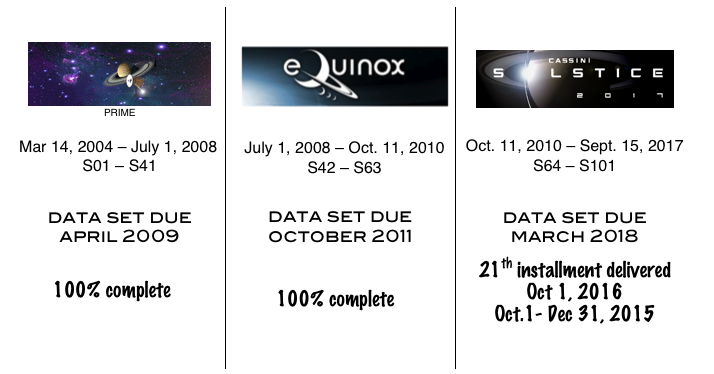The Cassini Timeline. The mission is divided into 4 phases: the Cruise Phase (including the
Jupiter Flyby Dec
2000-Jan 2001), the Prime Mission (including the
Huygens Probe Landing),
the Equinox Mission and the Solstice Mission. Data from all phases are stored sequentially in the PDS.
Mission Objectives
Mission Events
Oct 15, 1997: Cassini-Huygens launch
Apr 26, 1998: First Venus flyby
Jun24, 1999: Second Venus flyby
Aug 18, 1999: Earth-Moon flyby
Dec 30, 2000: Jupiter flyby
Mar 14, 2004: Prime Mission begins
June 11, 2004 Phoebe Flyby
Jul 1, 2004: Saturn orbit insertion
Oct 26, 2004: First flyby of Titan
Dec 24, 2004: Huygens probe is released
Jan 14, 2005: Huygens probe makes its descent
Jun 30, 2008: Prime Mission ends
Oct 11, 2010: Equinox Mission ends
Through 2017: Solstice Mission is continuing
Mission Summary
The Delivery Schedule.
Cassini data are delivered to the PDS 9-12 months after acquisition and are delivered every three months. PDS must validate those data before they are considered certified. This may result in a delay between the time when Cassini delivers data and the time when PDS makes the data available. Alternately, PDS may choose to put data online while they are being validated, stating that they are not certified. PDS urges caution when using any data that have been released by the PDS for less than three months.
Master Schedule (updated 12/22/16). This is an “as-planned” listing of observations spanning the interval from May 14, 2004 to November 22, 2016. The list contains 58,320 entries and may be downloaded and sliced and diced to make your own listing. In addition, the linked page allows you to determine DSN data drops to verify that the data should exist in the archive.
| Tables, Graphics and References Helpful in Scoping the Mission |
| Cassini Mission Overview |
| Cassini Tour Atlas (New) |
| Apoapses (revolution, epoch, period, orbital inclination, range) | (xlsx, txt) |
| Periapses (revolution, epoch, latitude, phase, period, range) | (xlsx, txt)
|
| Ring Plane Crossing (revolution, ascending, or descending epoch, range) | (xlsx, txt) |
| Dust Crossings (revolution, target, epoch) | (xlsx, txt) |
Dust Hazards (revolution, event, epoch) | (xlsx, txt) |
| Conjunctions (revolution, time) | (xlsx, txt) |
Orbital Inclination
References
Finding Cassini Data. Although the data from the various instruments are archived within the appropriate discipline nodes, it is assumed that the user would be interested in Saturn, Rings, Titan and other satellites or in fields and particles data; hence, these web pages are set up to facilitate searches of this sort.
Saturn
Rings
Titan
Icy Satellites
Small Satellites
Fields and Particles and Aurora data
Understanding the Instrument and the Archived Data. In an effort to supplement the limited availability of higher-order reduced data products, the Cassini Instrument Teams are generating users' guides to supplement the original documentation. Access to the guides and other useful information can be found at the following pages.
CAPS - Cassini Plasma Spectrometer
CDA - Cosmic Dust Analyzer
CIRS - Composite Infrared Spectrometer
HRD - High Rate Detector
INMS - Ion and Neutral Mass Spectrometer
ISS - Imaging Science Subsystem
MAG - Magnetometer
MIMI - Magnetospheric Imaging Instrument
RADAR - a Radar instrument
RPWS - Radio and Plasma Wave Spectrometer
RSS - Radio Science Subsystem
UVIS - Ultraviolet Imaging Spectrograph
VIMS - Visual and Infrared Mapping Spectrometer
Observation geometry in "SPICE" format may be obtained at the
NAIF node
Publications - A listing of team members to facilitate literature searches.
Access NASA's Planetary Photojournal for Public Relations
Information
More information can be found on the
Cassini web site at JPL.
Subscribe to the PDS
Subscription Service to be informed of new data releases.
 PDS: The Planetary Atmospheres Node
PDS: The Planetary Atmospheres Node
